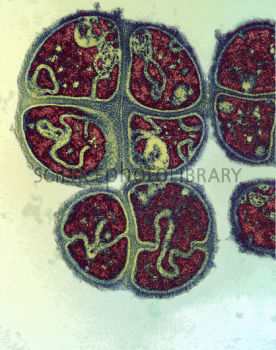Micrococcus tetragenus: Difference between revisions
| Line 9: | Line 9: | ||
==Description and Significance== | ==Description and Significance== | ||
""M. tetragenus"" is part of the Micrococcacae family. It is Gram positive and retains a spherical shape. It may be found in single or irregular groups of cells. [[#References | [1]]] This microbe is important because of its unique septation which is discussed in the following section. [[#References | [3]]] ""M. tetragenus"" has also been shown to cause septicemia. [[#References | [4]]] How does it relate to the other organisms in its phylum (bacteria and fungi) or group (archaea, virus, protist). Use the following for each reference in text (change number accordingly)--> [[#References | [1]]] | |||
==Structure, Metabolism, and Life Cycle== | ==Structure, Metabolism, and Life Cycle== | ||
Revision as of 12:02, 22 July 2013
Classification
Kingdom - Bacteria; Phylum - Actinobacteria; Class - Actinobacteria; Order - Actinomycetales; Family - Micrococcaceae
===Micrococcus tetragenus=== [1]
Description and Significance
""M. tetragenus"" is part of the Micrococcacae family. It is Gram positive and retains a spherical shape. It may be found in single or irregular groups of cells. [1] This microbe is important because of its unique septation which is discussed in the following section. [3] ""M. tetragenus"" has also been shown to cause septicemia. [4] How does it relate to the other organisms in its phylum (bacteria and fungi) or group (archaea, virus, protist). Use the following for each reference in text (change number accordingly)--> [1]
Structure, Metabolism, and Life Cycle
Interesting features of its structure; how it gains energy (how it replicates, if virus); what important molecules it produces (if any), does it have an interesting life cycle?
Ecology and Pathogenesis
Natural habitat (soil, water, commensal of humans or animals?)
If relevant, how does this organism cause disease? Human, animal, or plant hosts? Important virulence factors, as well as patient symptoms.
References
[1] NCBI Taxonomy. US Government, 28 Oct. 2009. Web. 22 July 2013. <http://www.ncbi.nlm.nih.gov/Taxonomy/Browser/wwwtax.cgi?mode=Info&id=1269&lvl=3&lin=f&keep=1&srchmode=1&unlock>.
[2] KWANGSHIN KIM/SCIENCE PHOTO LIBRARY, . Micrococcus tetragenus. 2013. Science Photo Library Ltd., London, UK. Web. 21 July 2013. <http://www.sciencephoto.com/media/12343/view>.
[3] Slonczewski, Joan L., and John W. Foster. Microbiology: An Evolving Science. 2ndnd ed. N.p.: n.p., 2009. 103-05. Print.
Author
Page authored by Samuel Goldenberg, student of Mandy Brosnahan, Instructor at the University of Minnesota-Twin Cities, MICB 3301/3303: Biology of Microorganisms.

